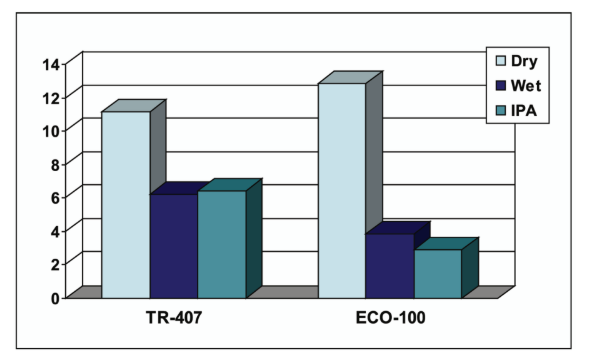Enhanced TDS
Identification & Functionality
- Blend
- No
- CASE Ingredients Functions
- Chemical Family
- Country of Origin
- Function
- Binder
- Industrial Additives Functions
- Product Code
- MITM15372
- Single Ingredient
- Yes
- Technologies
- Product Families
Features & Benefits
- CASE Ingredients Features
- Industrial Additives Features
- Labeling Claims
- Product Benefits
- APE-free
- Ultra low formaldehyde*
- High tensile strength
- Stiff hand
- Excellent wash durability
- Self-crosslinking
- Good color and formulation stability
- Excellent runnability
*Ultra low formaldehyde: no formaldehyde or formaldehyde generators intentionally added.
Applications & Uses
- Coating End Applications
- Compatible Substrates & Surfaces
- Industrial Additives End Use
- Markets
- Applications
- Product Applications
- RHOPLEX® ECO-3482 combines a very soft hand with tensile strength and durability.
- The following are typical laboratory test results comparing RHOPLEX® ECO-3482 to RHOPLEX TM ST-954, a conventional self-crosslinking acrylic binder with a Tg of -23°C.
- This application was performed on wood pulp (Whatman #4 filter paper) with about 25% solids add-on.
- The samples were dried/cured at 150°C for 3 minutes in a laboratory Mathis oven.
Properties
- Physical Form
Technical Details & Test Data
- Technical Data
The tensile strengths were tested in the cross-machine direction and are reported in kg/inch.
For the wet and IPA strengths, the samples were soaked in water or IPA for 30 minutes before testing.
RHOPLEX® ECO-3482 has performances close to a conventional self-crosslinking binder without the associated formaldehyde emissions or residual formaldehyde in the final nonwoven.
Packaging & Availability
- Packaging Type
Principal Information
- Group Principal Number
- S000005
- Principal
Storage & Handling
- Handling Information
- Keep combustible and/or flammable products and their vapors away from heat, sparks, flames and other sources of ignition including static discharge.
- Processing or operating at temperatures near or above product flashpoint may pose a fire hazard.
- Use appropriate grounding and bonding techniques to manage static discharge hazards.
- Failure to maintain proper volume level when using immersion heaters can expose tank and solution to excessive heat resulting in a possible combustion hazard, particularly when plastic tanks are used.
- Storage Conditions
Store products in tightly closed original containers at temperatures recommended on the product label.
Other
- Color (SDS)
- White milky
- Item Number
- Odor (SDS)
- Acrylic like
- Protect from Freezing
- Yes
- Temperature Control
- Yes
- USA/DOT UN Number
- Not Applicable
- Chemical Properties
Value Units Test Method / Conditions pH 5.5 - - Material Composition
Value Units Test Method / Conditions Solid Content 43.0 % % - Physical Properties
Value Units Test Method / Conditions Density 8.7 lb/gal lb/gal at 25°C Glass Transition Temperature (Tg) -27.0 °C °C Specific Gravity 1.04 - Storage Temperature 34.0-120.0 °F °F Viscosity 250.0 cPs cPs Brookfield Viscometer - SDS Physical and Chemical Properties
Value Units Test Method / Conditions Boiling Point (SDS) 100.0 °C °C Evaporation Rate (SDS) max. 1.0 % % Butyl Acetate=1 Melting Point (SDS) 0.0 °C °C Relative Vapor Density (SDS) max. 1.0 - Air=1 Specific Gravity (SDS) 1.0-1.2 - Water = 1 Vapor Pressure (SDS) 17.0 mm Hg mm Hg at 20°C Viscosity (SDS) max. 500.0 mPa.s mPa.s Volatile Content (SDS) 56.0-57.0 % % Water pH (SDS) 4.5-6.5 - - Shelf Life & Stability
Value Units Test Method / Conditions Shelf Life 0.0 d d
